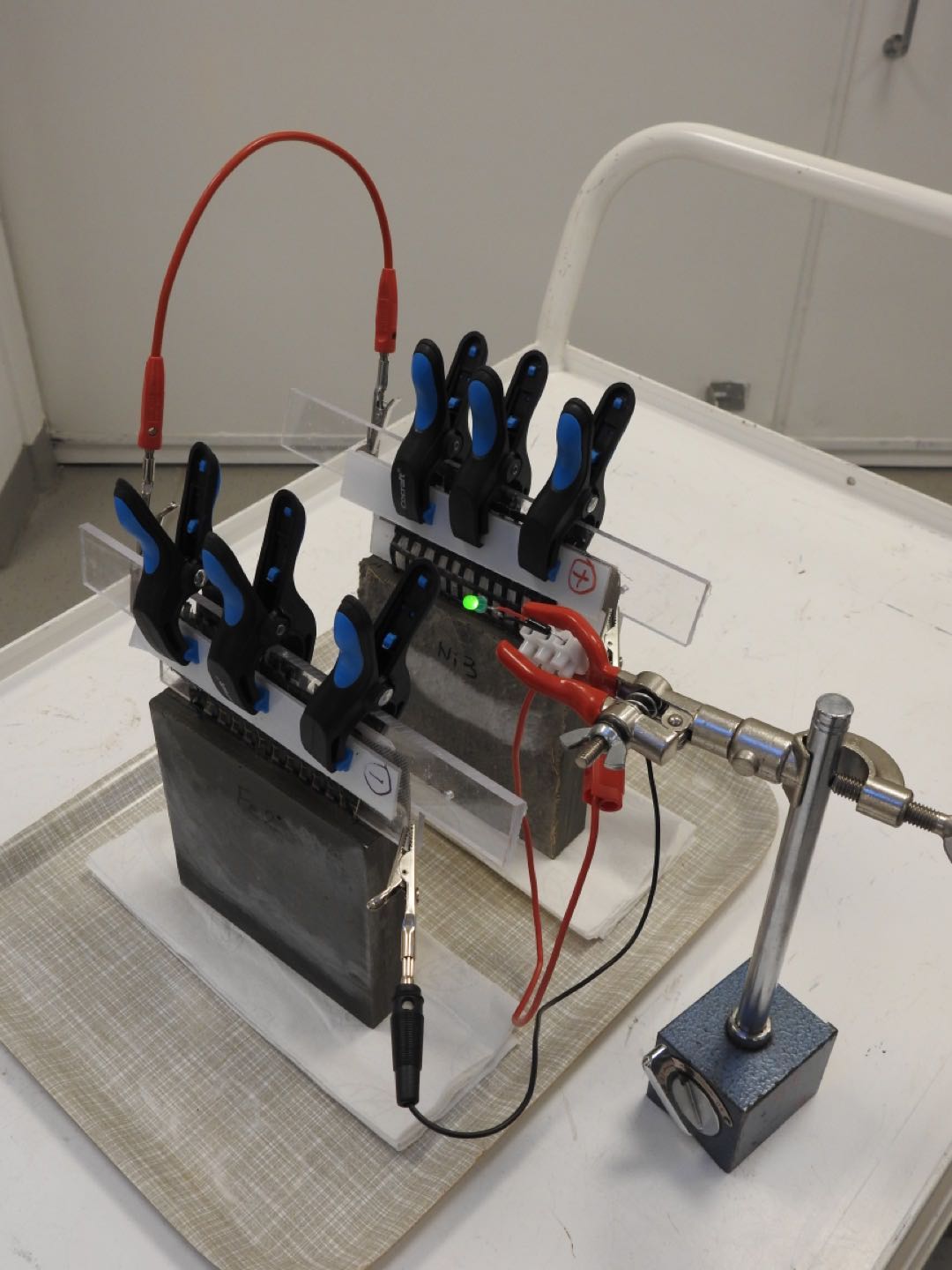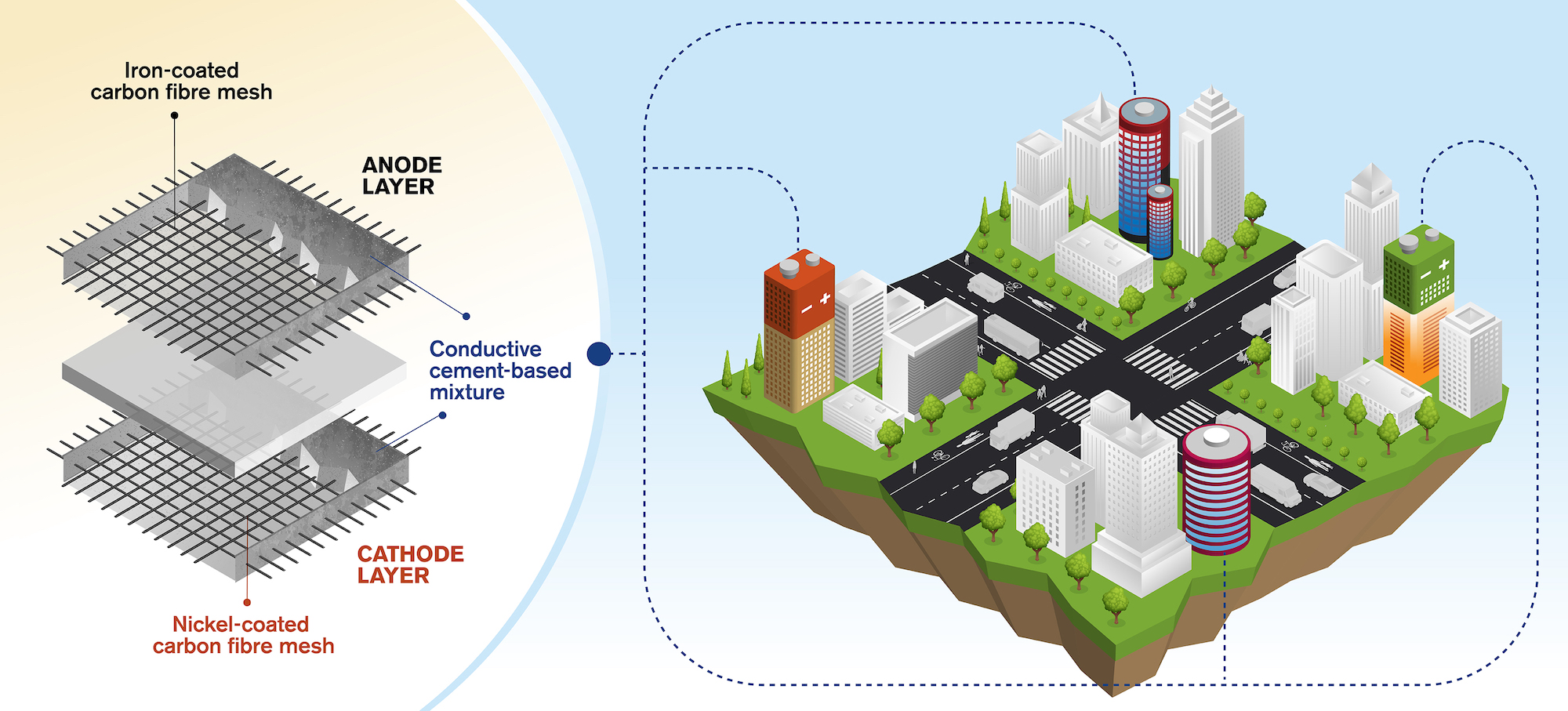Researchers from the Department of Architecture and Civil Engineering at Chalmers University of Technology in Gothenburg, Sweden, have created a concept for rechargeable batteries made of cement.
The concept involves a cement-based mixture with small amounts of short carbon fibers added to increase conductivity and flexural toughness. Embedded within this mixture is a metal-coated carbon fiber mesh—iron for the anode and nickel for the cathode. Several combinations for the electrodes were tested before the iron anode and nickel-based oxide cathode were found to yield the best results. Additionally, researchers had to experiment with different ratios of carbon fiber before finding an optimal mixture of around 0.5% carbon fiber to improve the cement-based mixture’s conductivity for the electrolyte.
The resulting cement-based battery has an average density of 7 watt-hours per square meter during six charge and discharge cycles—low in comparison to commercial batteries, but still potentially very beneficial to the built environment considering the large volume at which the battery could be constructed when used in buildings, bridges, dams, and other concrete structures.

The research team—led by Chalmers Professor Luping Tang and Emma Zhang, PhD, formerly with the university, now Senior Development Scientist at Delta of Sweden—envisions possible applications for the concept that range from powering LEDs, providing 4G connections in remote areas, and cathodic protection against corrosion in concrete infrastructure.
“It could also be coupled with solar cell panels to provide electricity and become the energy source for monitoring systems in highways or bridges, where sensors operated by a concrete battery could detect cracking or corrosion,” said Zhang.
Technical questions that need to be answered before commercialization of the concrete technology include extending the service life of the battery and the development of recycling techniques. The batteries would need to either be able to match the 50-100 year life of a typical concrete building or be made easier to exchange and recycle when their service life is over.
Despite these obstacles, the researchers are optimistic the concept has plenty to offer as a future building material that contributes to additional functions such as renewable energy sources.
Related Stories
3D Printing | Sep 13, 2024
Swiss researchers develop robotic additive manufacturing method that uses earth-based materials—and not cement
Researchers at ETH Zurich, a university in Switzerland, have developed a new robotic additive manufacturing method to help make the construction industry more sustainable. Unlike concrete 3D printing, the process does not require cement.
Smart Buildings | Jul 25, 2024
A Swiss startup devises an intelligent photovoltaic façade that tracks and moves with the sun
Zurich Soft Robotics says Solskin can reduce building energy consumption by up to 80% while producing up to 40% more electricity than comparable façade systems.
Great Solutions | Jul 23, 2024
41 Great Solutions for architects, engineers, and contractors
AI ChatBots, ambient computing, floating MRIs, low-carbon cement, sunshine on demand, next-generation top-down construction. These and 35 other innovations make up our 2024 Great Solutions Report, which highlights fresh ideas and innovations from leading architecture, engineering, and construction firms.
Building Technology | Jun 18, 2024
Could ‘smart’ building facades heat and cool buildings?
A promising research project looks at the possibilities for thermoelectric systems to thermally condition buildings, writes Mahsa Farid Mohajer, Sustainable Building Analyst with Stantec.
75 Top Building Products | Apr 22, 2024
Enter today! BD+C's 75 Top Building Products for 2024
BD+C editors are now accepting submissions for the annual 75 Top Building Products awards. The winners will be featured in the November/December 2024 issue of Building Design+Construction.
AEC Tech | Feb 20, 2024
AI for construction: What kind of tool can artificial intelligence become for AEC teams?
Avoiding the hype and gathering good data are half the battle toward making artificial intelligence tools useful for performing design, operational, and jobsite tasks.
Sustainability | Nov 1, 2023
Researchers create building air leakage detection system using a camera in real time
Researchers at the U.S. Department of Energy’s Oak Ridge National Laboratory have developed a system that uses a camera to detect air leakage from buildings in real time.
Resiliency | Aug 7, 2023
Creative ways cities are seeking to beat urban heat gain
As temperatures in many areas hit record highs this summer, cities around the world are turning to creative solutions to cope with the heat. Here are several creative ways cities are seeking to beat urban heat gain.
AEC Innovators | Jun 15, 2023
Rogers-O'Brien Construction pilots wearables to reduce heat-related injuries on jobsites
Rogers-O'Brien Construction (RO) has launched a pilot program utilizing SafeGuard, a safety-as-a-service platform for real-time health and safety risk assessment. Non-invasive wearables connected to SafeGuard continuously monitor personnel to prevent heat exhaustion on jobsites, reducing the risk of related injuries. RO is the first general contractor to pilot this program.
Office Buildings | May 15, 2023
Sixteen-story office tower will use 40% less energy than an average NYC office building
This month marks the completion of a new 16-story office tower that is being promoted as New York City’s most sustainable office structure. That boast is backed by an innovative HVAC system that features geothermal wells, dedicated outdoor air system (DOAS) units, radiant heating and cooling, and a sophisticated control system to ensure that the elements work optimally together.

















